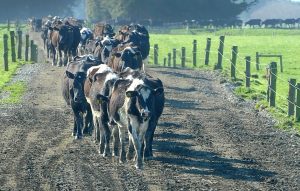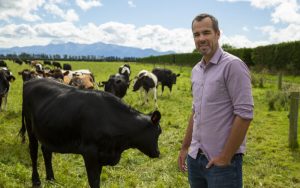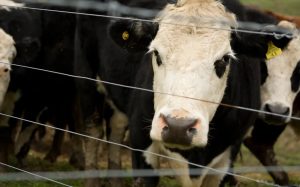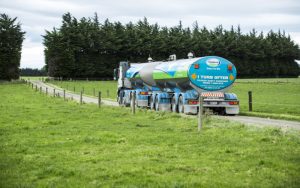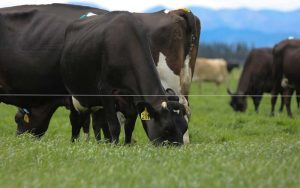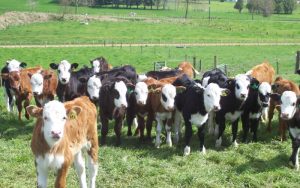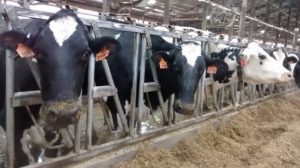
Almost 20 years ago, hundreds of furious New Zealand farmers jumped into their tractors, farm bikes and trucks and ploughed up Wellington’s main street towards parliament to kick up a stink against the so-called “fart tax” – a levy on livestock methane gases, proposed by the then-Labour government to reduce emissions.
A cow named Energy was led up the building’s granite steps and left an unwelcome mess in her wake. In doing so, she provided the opposition movement with a powerful, if indelicate, visual metaphor: rural New Zealand was ready for a mudslinging match with the capital. Just months later, the government abandoned the tax.
Amid the country’s bold claims over tackling climate change – including declaring a climate emergency and passing multipartisan climate legislation – New Zealand’s progress towards bringing down its rocketing agricultural emissions (responsible for half the nation’s total) has been glacial.

The Pacific nation is one of the world’s worst performers on emission increases, partly because powerful farming lobby groups have long stonewalled policy that puts a price on the climate cost of farming.
But last month – 19 years after Energy’s memorable performance – the current Labour-government proposed a not-too-dissimilar plan to the ill-fated “fart tax”, with a crucial difference: it had been broadly created by farmers themselves.
Dressed in a pair of clean gumboots and standing behind a podium of hay bales at a Wairarapa dairy farm, prime minister Jacinda Ardern announced what she called a “pragmatic” world-first scheme that will require farmers to pay for their agricultural greenhouse gas emissions in a “split-gas” approach – levies on the methane belched out by cows and nitrous oxide emitted mostly through livestock urine.
On the eve of Cop26, New Zealand pledged to halve its emissions by 2030 as part of the Paris agreement to limit global warming to 1.5C. The target was criticised for focusing too heavily on offsetting carbon overseas and through forestry, rather than addressing the root causes such as agriculture. The country has also set a domestic target of a 2030 target of a 10% reduction below 2017 biogenic methane levels under its climate change law.
On Saturday, the Cop27 climate conference will be focusing on agriculture, and New Zealand hopes their plan may provide a blueprint for other countries to follow. Ardern believes the latest emissions pricing plan will help New Zealand meet these goals. But the nation may be wary of the efficacy of such plans, given the country’s poor record in meeting targets so far.

No country has yet succeeded in implementing an agricultural emissions levy plan, and those that have tried are frequently met with industry opposition. In recent months, Dutch farmers have expressed fury at their government’s attempt to reduce nitrogen pollution.
Domestically, there are rumblings of discontent over the announcement. But those working in agriculture and climate policy say the turnaround in the government/farmer relationship is nothing to be sniffed at.
“As everyone knows, the farming lobby is one of the strongest,” says Dr Adrian Macey, an adjunct professor in climate change research at Victoria University of Wellington and senior associate at the Institute for Governance and Policy Studies. “When you look at the amount of foreign exchange that comes from the farming sector, you may understand why they are a powerful voice.”
But there is growing division within the sector, he says – those who are “ready to be part of the solution”, and those who feel “very oppressed by not only climate change measures but all government regulation”.
The emissions proposal, which is expected to be signed off by cabinet in early 2023, was formulated from a set of recommendations devised under a scheme called He Waka Eke Noa – a partnership between farming leaders, Māori and government.
It was created in 2019 after calls from the farming sector which wanted to price greenhouse gas emissions at farm level, rather than being forced into the separate Emissions Trading Scheme, which they criticised as being a blunt tool to calculate agricultural emissions.
The process has been “a good idea” and “the right sort of engagement with the sector”, Macey says, adding that the plan that farmers came up with was “acceptable enough” and useful because “it encouraged the sector to try work together, rather than pursue their own agendas.”
The government has largely accepted the scheme’s proposals, which include reduced levies and generous incentive payouts, but rejected two major recommendations: that farmers set their own levy and that all on-farm planting leading to carbon sequestration be recognised in a bespoke scheme to offset levy costs.
Additionally, due to the way emissions pricing will be calculated, beef and sheep farmers will feel the sting of a levy more acutely, which the plan suggests could lead to a 20% reduction in that type of farming, compared with roughly 5% in dairy – despite dairy being more profitable and contributing more emissions overall.
Some farmers are not happy about the rejected recommendations. The plan would “rip the guts out of small town New Zealand”, says Andrew Hoggard, the Federated Farmers president. “[Farmers] will be selling up so fast you won’t even hear the dogs barking on the back of the ute as they drive off.”

Meanwhile, environmental groups such as Greenpeace are dismayed dairy is not being targeted more. “It’s greenwash,” says spokesperson Christine Rose. “The industry has still managed to secure a system that won’t properly regulate, price or cut methane emissions.” Greenpeace and other groups believe herd sizes must be dramatically reduced, the use of synthetic fertiliser slashed and a shift to plant-based regenerative organic farming prioritised.
Creating policy that threatens a nation’s biggest economic sector while trying to meet international obligations on climate change can be a dilemma for political parties.
“[New Zealand] is a little bit between a rock and a hard place,” says Robyn Dyne, a senior scientist at AgResearch, who specialises in sustainable production systems. “We know we’ve got to have a pathway forward, we know there’s not an appetite to keep kicking the can down the road, and yet we do need to have the industry on the journey.”
But Dynes believes the proposal “seems sensible” and that the government has got the balance broadly right. “It’s evidence-based, it has recognised the essential need for a split-gas approach, and it has also taken a farm-level approach. I think that’s important as well, because our farmers will be motivated by being recognised for what they do.”
Dynes believes the partnership between farmers and government has been genuine, but she stops short of predicting if the plan will get over the line.
Macey, meanwhile, is more confident and believes partnership and consultation is the key to successful climate policymaking. “The stakes are quite high in this consultation,” he says. “If the points being made by the farming sector are reasonable, and the government is seen to reject them without good reasons, they risk fracturing that consensus.”
Macey says the plan could pave the way for other countries to follow suit. “[New Zealand] is probably the first country to set a hard target on agricultural methane and the first country to put a levy on it,” he said. “We’re showing world leadership on what you can do with the sector – no one has gone there before us.”




